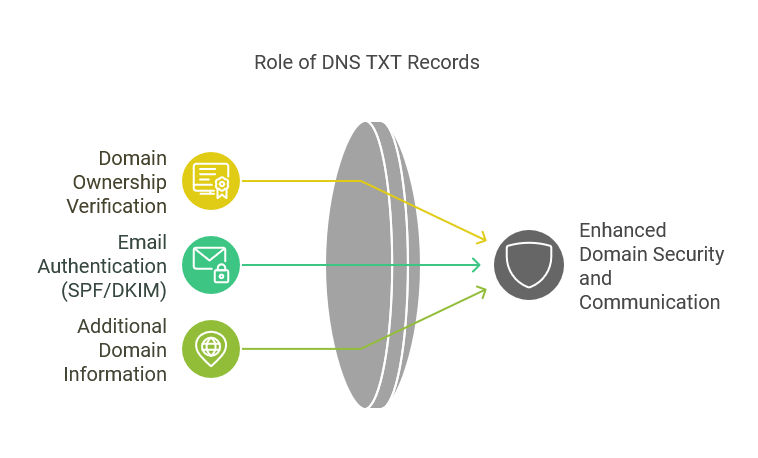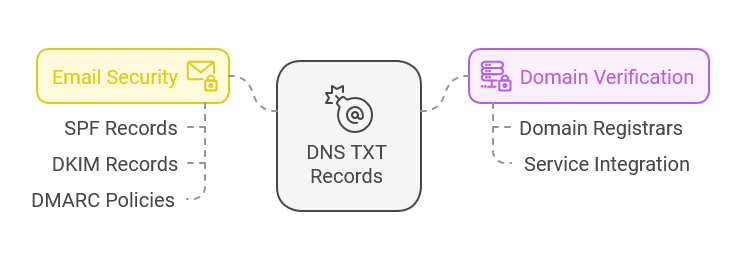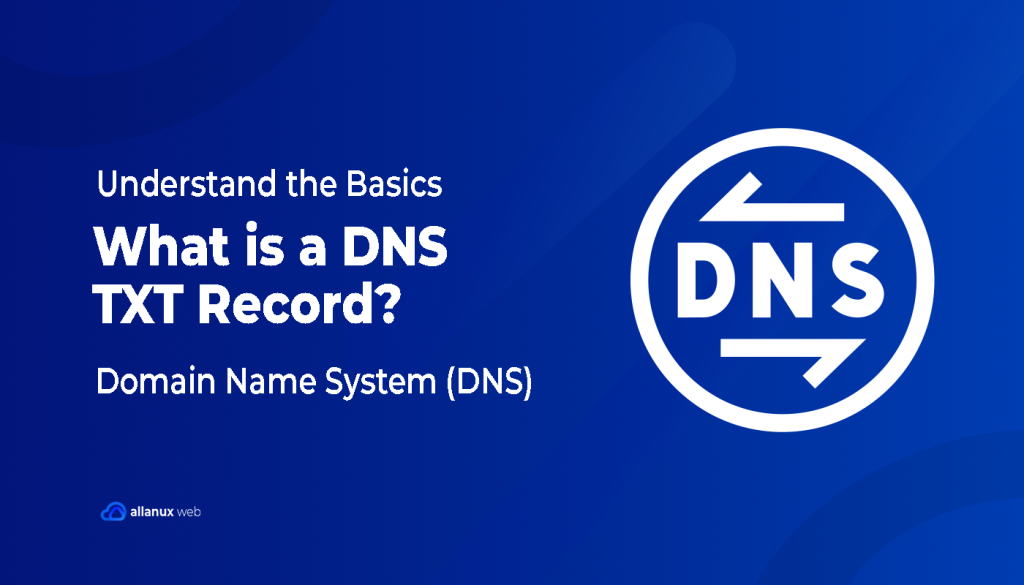Have you ever heard that a DNS TXT record could be key in making your emails safe? Since 1993, the DNS TXT record has been essential for domain verification and email security. It’s a must-have in the domain name system.
DNS TXT records started as a way to add notes to a domain’s DNS settings. But now, they do more, like providing data for the internet and instructions for email authentication. By setting these records right, you can fight off email scams and block spam. This helps keep your digital messages secure.
Even with a 255 character limit, DNS TXT records have many uses. They can encode important policies or offer a way for smart security measures. To check these records, groups use command line tools or online DNS lookup tools. This improves both domain safety and how well things run.
As online threats get smarter, knowing about DNS TXT records is more important than ever. This guide will teach you to set them up to guard your domain. It makes sure your online space is secure.
Introduction to DNS TXT Records
DNS TXT records are essential in the Domain Name System (DNS), linking text with domain names. They were first seen in 1987, according to DNS specs (RFC 1034 and 1035). Today, they’re key for setting up emails and proving you own a domain.
TXT records help make emails safer through SPF, DKIM, and DMARC protocols. SPF lets domains name their approved mail servers. DKIM gives a way to check if emails are real. DMARC sets rules to fight fake emails.
Also, TXT records prove you own your domain. This is handy for tools like Google Search Console and Webmaster Tools. They also share important info or notices about a domain, covering many admin needs.
Websites like mxtoolbox.com/TXTLookup.aspx and tools like dig make it easy to check a domain’s TXT records. This step is crucial to fix issues, confirm settings, and make sure DNS is right. ICANN, for example, uses TXT records to meet SPF standards.
TXT records can hold lots of data, up to 255 characters per string. They have a Time-to-Live (TTL) value too. This shows how long DNS servers should remember them.
Overall, DNS TXT records do a lot within the DNS world. They boost email security and confirm domain ownership, supporting many key domain tasks.
What is a DNS TXT Record?
Understanding what is a DNS TXT record is crucial for web security. These records are parts of the DNS that store text info. They help with domain verification and improve email security.
Text records are very flexible in their format. They are made of attribute-value pairs. This flexibility allows for a broad range of uses. Text records can have up to 255 characters. If more space is needed, strings can be joined together. An example is a DMARC policy like v=DMARC1; p=quarantine rua=mailto:[email protected].
DNS TXT records play a key role in keeping emails secure. They use digital signatures through DKIM. This checks that emails remain unchanged in transit. SPF records also use TXT records to limit email spoofing by listing authorized IP addresses.
Setting up DKIM, SPF, and DMARC records is vital. They guard against phishing and email spoofing. This secures communications from your domain. Admins can update these records as needed to meet new security challenges.
DNS TXT records hold a wide variety of info, making them crucial for web admins. By understanding these records, domain owners can use DNS to enhance security. This helps protect and validate their domain online.
How DNS TXT Records Work
DNS TXT records are key for anyone wanting to truly grasp their use. They mainly hold text for things like proving who owns a domain, making email safer, and more. They are highly valuable in the internet world because of their many uses.

DNS TXT Record Format
The TXT record format is simple yet potent. It’s basically a string of characters inside a quotation mark. This format can carry different kinds of data. It’s versatile for varied needs. For example, DKIM records, a kind of TXT record, have public keys to sign emails. This helps keep them safe while they move across the internet.
Key points about the TXT record format include:
- Attribute and Value: The data is split into an attribute and its related value. This organizes the information well.
- Multiple Uses: These records are not just for security. They can also hold SPF data, policy details, and contact information.
Character Limitations
Character limitations set a cap on the TXT string size. Strings can’t be over 255 characters. If they are, they must be broken into smaller parts within quotes. This is so DNS servers can understand them. Google says to keep it under 49 TXT records per domain, as that’s the max most places allow.
When setting up DKIM, SPF, or DMARC records, remember these limits. Longer values will need to be carefully broken up:
- SPF Records: Even though not widely used now, SPF info can still be kept in TXT records. This helps block spam.
- DMARC Records: These are for controlling how email checks are handled. They help fight spam and phishing.
- DKIM Records: This is for email security. It encrypts messages to protect their content and keep them private.
Knowing about character limitations is crucial for DNS TXT records to work right. This prevents any setup mistakes.
Common Uses of DNS TXT Records
TXT records in the DNS protocol are multi-use tools. They are key for domain and email security measures. This includes email authentication and checking if someone owns a domain.

Email Security
Email security benefits greatly from TXT records. They allow only approved mail servers to send emails for your domain. For example, *SPF records* use a special code to stop email fraud. This ensures that emails come from trusted servers.
*DKIM records*, part of TXT records, confirm the sender’s identity. They use digital signatures to protect emails from being changed. To make email even safer, *DMARC policies* tell how to deal with emails that fail checks.
Domain Verification
TXT records are also used to prove you own your domain. You might need to add codes from your domain registrar or companies like Google. This shows that the right person controls the domain.
Many services use TXT records for this reason. It helps link things like Microsoft 365 and G-Suite to your domain. This makes sure your email service is secure and well-managed.
The flexible use of TXT records helps keep domains safe, proves who owns them, and ensures trustworthy email communication.
How to Add a DNS TXT Record
Adding a TXT record to your domain is key for proving you own it. It also boosts email security and sets up other important services. First, you need to go into your DNS management settings. Then, you put in the right details for the TXT record. We’ll show you how to smoothly add a new TXT record to your domain.
Logging into Your Domain Hosting Control Panel
To start, log into your domain hosting control panel. Your domain registrar should give you access to this. Once you’re in, find the DNS management area. It lets you look at, add, or change DNS records. That includes putting in new TXT records.
Configuring the TXT Record
Next, go to the DNS management part to add a TXT record. Click to create a new TXT record. This will ask you for some important info:
- Type: Make sure you pick ‘TXT’ for the record type.
- Host: Usually, this is your domain name. Sometimes, you might need a subdomain.
- Value: Put in the text or data the TXT record needs. This could be codes for checking who owns the domain, SPF strings, or other needed data.
- TTL (Time to Live): For things like Email Security and checking your domain with services like Microsoft 365, you should set the TTL to 3600 seconds (one hour). For MX records, set TTL to 3600 too.
After you fill in all the details, submit to create the new TXT record. Usually, it takes about 15 minutes for the changes to show up. But, the whole process to update everywhere (DNS propagation) can take up to 72 hours. This depends on your DNS provider.
By doing these steps, you’ll be able to add a TXT record to your domain easily. This makes sure your domain is verified, your email is more secure, and you can set up more services efficiently.
Benefits of Using DNS TXT Records
The benefits of TXT records are many. They greatly improve domain management’s security and functionality. One key advantage is enhancing email security. By using SPF, DKIM, and DMARC, domain owners can stop email spam and phishing. This protects their email communication.
TXT records also help with domain authentication. They confirm domain ownership which is important for many online services. This check makes sure only the right people use and manage the domain.
Here are some notable advantages:
- Email Verification: Stops spammers and phishing attacks by ensuring emails sent are from your domain.
- Flexible Configuration: You can change or remove TXT records as needed. This allows for security adjustments over time.
- Coexistence: These records work well with A, MX, and CNAME records. It adds flexibility to your DNS settings.
- DNS Propagation: Changes in DNS can spread fast, often quicker than 24 hours. This lets you update settings promptly.
It’s important to routinely check and update TXT records. Do this especially if there are changes in email settings or domain ownership. Keeping TXT records current ensures they are effective.
Using TXT records boosts email security and domain authentication. This reduces risks and protects your online presence. It’s a smart move for domain owners.
Troubleshooting Common Issues with DNS TXT Records
Dealing with DNS TXT record issues can be a hassle. However, knowing common problems makes fixing them easier. A big issue is the delay in changes taking effect. This can take up to 72 hours, depending on the TTL value of the record. To speed up updates, setting the right TTL values is important.
Mistakes in syntax are another common issue. For DNS TXT records to work right, the correct syntax is key. Use tools like Google’s free DNS record lookup to check your TXT record’s values. If the formatting is wrong, you’ll run into problems with your TXT record.
Having too many records can also cause trouble. When you use nslookup, it might show several TXT records for your domain. Managing these records well is vital to avoid issues. This is especially true for domain verification and email security measures like SPF, DKIM, and DMARC.
If your domain is managed by Google through its partners, you usually don’t need a TXT record to prove you own it. But, if you’re having trouble with TXT records, get in touch with your domain host. They offer support through live chat from Monday to Friday, 4:00 AM to 8:00 PM EST, or email support anytime.
DNS TXT records are used for things like verifying ownership and setting up security protocols. To improve security, consider using DNSSEC. This lets users check the record’s authenticity. By keeping syntax correct, setting proper TTL values, and managing records well, you can fix many DNS TXT issues.
Other Types Of DNS Records
Understanding different DNS record types helps in grasping how DNS works. Each DNS record is vital in a DNS zone. They are key to managing and accessing information online.
The A record is well-known. It connects domain names to IP addresses. For instance, entering www.example.com in a browser uses the A record to find the right IP address. It makes browsing the web smooth for users.
Then there’s the CNAME record. It lets one domain name redirect to another. It’s great for linking multiple domains to a single main domain. This makes managing domains easier and keeps subdomains consistent.
Email servers use specific DNS records. The SPF record, a type of TXT record, lists allowed mail servers for a domain. It helps stop email spoofing. The DKIM record adds extra security by verifying email signatures, ensuring a message’s authenticity.
Knowing about DNS record types is useful. From A to CNAME, SPF, and DKIM records, each plays a role. Together, they ensure the internet’s structure works well. They keep web and email services running smoothly and securely.
Conclusion
Learning about DNS TXT records is key for any domain manager. This knowledge can boost your domain’s safety and trustworthiness. If you use SPF, DKIM, and DMARC for email, or if you verify domains, setting up TXT records helps protect against phishing and spam.
With Gcore DNS Hosting, you get an average speed of 30 ms. This speed shows how fast and efficient modern DNS solutions are. Gcore offers options like Geobalancing. They also have plans from free to enterprise levels. This makes managing DNS records easy and effective for all administrators.
When you know about DNS TXT records, you can do a lot. You can secure emails, send info to machines, and prove you own your domain. With over 50 types of DNS records, understanding TXT records is very important. It makes your domain system more secure and efficient.
DNS TXT records are essential for those who want to improve their domain. By learning and using these practices, you can manage DNS settings better. This prepares you to face the challenges of the digital world today.
Here’s an extended FAQ with questions and answers for “What is a DNS TXT Record? Understand the Basics.” in the requested format:
FAQs
Q: What is a DNS TXT Record?
A: A DNS TXT (text) record is a type of DNS record that contains machine-readable text information about a domain. TXT records are versatile and can be used for various purposes, including domain ownership verification, email spam prevention, and providing additional information about a domain.
Q: How do TXT records help prevent email spam?
A: TXT records help prevent email spam by allowing domain administrators to implement email authentication protocols such as SPF (Sender Policy Framework), DKIM (DomainKeys Identified Mail), and DMARC (Domain-based Message Authentication, Reporting, and Conformance). These protocols help verify that emails are sent from authorized sources, reducing the likelihood of spam and phishing attempts.
Q: What is an SPF record and how does it relate to TXT records?
A: An SPF (Sender Policy Framework) record is a specific type of TXT record used for email authentication. It specifies which mail servers are authorized to send emails on behalf of a domain. SPF records help prevent email spoofing and reduce spam by allowing receiving mail servers to verify if an incoming email is from a trusted source.
Q: How do TXT records verify domain ownership?
A: TXT records are commonly used to verify domain ownership for various services. When you need to prove that you own a domain, a service provider may ask you to add a specific TXT record with a unique verification string to your domain’s DNS settings. Once added, the service can perform a TXT record lookup to confirm your ownership of the domain.
Q: Can you have multiple TXT records for your domain?
A: Yes, you can have multiple TXT records for your domain. This is useful for implementing various authentication protocols (like SPF and DKIM) simultaneously, as well as for other purposes such as domain verification for different services. Each TXT record serves a specific purpose and can coexist with others without conflict.
Q: How do you add a TXT record to your domain?
A: To add a TXT record to your domain, you typically need to access your domain’s DNS management interface through your domain registrar or hosting provider. Look for an option to add a new record, select TXT as the record type, and then enter the required information, such as the host (usually @, representing the root domain) and the TXT value (the content of the record). Save the changes, and allow time for propagation.
Q: What are DKIM records and how do they use TXT records?
A: DKIM (DomainKeys Identified Mail) records are another type of TXT record used for email authentication. They contain a public key that receiving mail servers use to verify the digital signature of incoming emails. By implementing DKIM, domain administrators can help ensure that their outgoing emails are not tampered with during transit and are truly from their domain, further helping to prevent email spam.
Q: How can you perform a TXT record lookup?
A: You can perform a TXT record lookup using various online DNS lookup tools or through the command line. On Windows, you can use the nslookup command in Command Prompt, while on Mac or Linux, you can use the dig command in Terminal. Simply specify the domain name and the TXT record type in your query to retrieve the existing TXT records for that domain.





